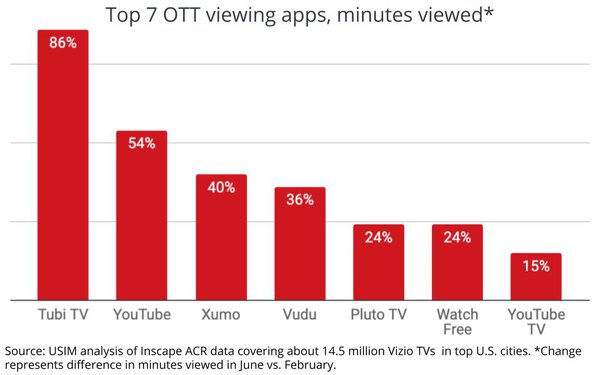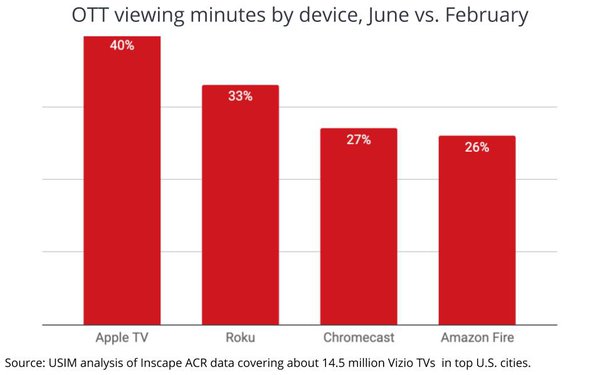
The COVID-19 pandemic has been a
"perfect storm" that has accelerated adoption and usage of app-based TV viewing that has brought the OTT marketplace to an inflection point that is likely to fundamentally alter the way advertisers
and agencies plan, buy and think about the TV advertising mix. That's the top line conclusion of an in depth analysis of app-based TV viewing data being released this week by independent media
services agency USIM.
USIM, a relatively smaller agency that has been a pioneer in developing OTT, addressable and programmatic TV advertising markets, analyzed four months of total viewing
minutes data for 14.5 million households in top U.S. cities including Charlotte, Chicago, Columbus, Dallas-Ft Worth, Jacksonville, Los Angeles, Nashville, New York, Philadelphia, Phoenix, San
Antonio, San Francisco to understand how viewer behavior has been reshaped during the pandemic.
advertisement
advertisement
The data, provided by ACR service Inscape, analyzed viewing of the "main screen" in Vizio TV
households between February (pre-pandemic) and June (post-pandemic), and found substantial decreases viewing share to linear TV channels, as app-based and device-based OTT viewing services surged
during the period.
While linear TV minutes viewed via cable and satellite TV grew about 5% during the period, its share of total viewing declined 6.5 percentage points to 49% do to
corresponding increases in streaming services and app-based TV viewing.
Free, ad-supported TV and movie service Tubi TV, which was recently acquired by Fox for $440 million, saw he greatest
surge, rising 86% between February and June, while all other app-based services grew significantly (see chart above).
The analysis also found that Apple TV was the biggest beneficiary in terms
of minutes viewed among the major devices, followed by Roku, Google's Chromecast and Amazon Fire (see chart below).
The analysis doesn't control for seasonability, but historically TV usage
levels are higher in cold weather months like February and lower in warm season months like June, so the trend appears to support USIM' perfect storm scenario.
"It has opened the floodgates,"
says Rob Jayson, executive vice president-insights and analytics as USIM, adding that the pandemic conditions of people stuck at home, starved for content, and in many cases, looking for more
cost-effective alternatives to subscription TV services, has essentially forced millions of Americans to sample app-based OTT services that might otherwise have taken years to develop.
"Now
that people have discovered that they can get this for free, I think the shift will continue," he said, adding that the consumer behavior changes is also unlocking tremendous opportunities in terms of
OTT advertising inventory, especially the kind that can be leveraged to target people at an addressable and hyper-local level.
That, says USIM President Russell Zingale could fundamentally
alter the way some advertisers and agencies plan and buy television.
He says many have already begun to embrace addressable TV advertising as more inventory has been made available
in recent years, but the acceleration of app-based TV viewing represents an inflection point that will make it difficult for others to ignore.
"Addressable was always kind of an add-on, but
its becoming a primary need," he says, adding, that the shift likely will lead to changes in the way advertisers think about reach and frequency planning models.
"Addressable gives
us the ability to control frequency to the household level, so we’re not just bombarding 25 exposures to a household," he points out.
While it may be impossible to predict the long-term
impact the pandemic and economic recession will have on America's viewing patterns, USIM's Jayson says many Americans have already changed the way they think about their main screen viewing, and that
app-based services are now a permanent part of their behavior.
He said the resumption of live sports programming -- especially if the NFL season resumes -- will bring many Americans back to
linear TV channels, but that apps and streaming services are now a permanent part of their household viewing.
